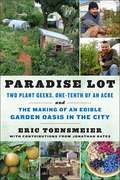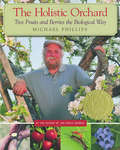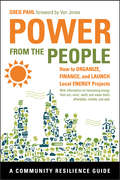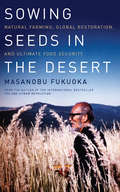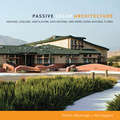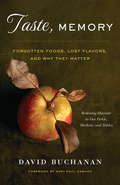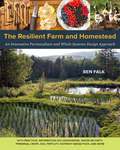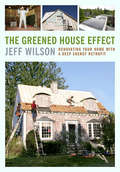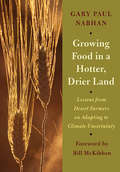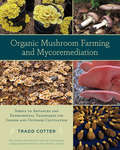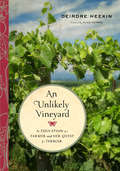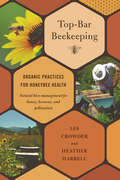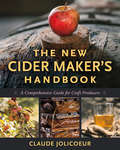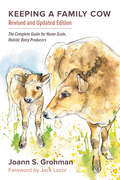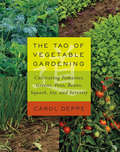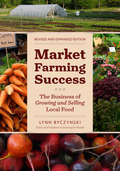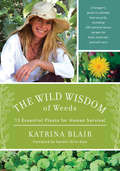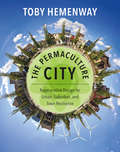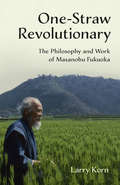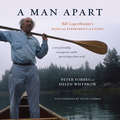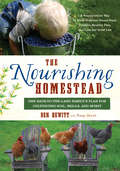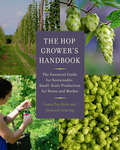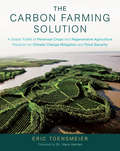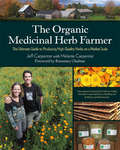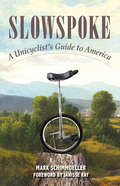- Table View
- List View
Paradise Lot: Two Plant Geeks, One-Tenth of an Acre, and the Making of an Edible Garden Oasis in the City
by Eric Toensmeier Jonathan BatesWhen Eric Toensmeier and Jonathan Bates moved into a duplex in a run-down part of Holyoke, Massachusetts, the tenth-of-an-acre lot was barren ground and bad soil, peppered with broken pieces of concrete, asphalt, and brick. The two friends got to work designing what would become not just another urban farm, but a "permaculture paradise" replete with perennial broccoli, paw paws, bananas, and moringa—all told, more than two hundred low-maintenance edible plants in an innovative food forest on a small city lot. The garden—intended to function like a natural ecosystem with the plants themselves providing most of the garden's needs for fertility, pest control, and weed suppression—also features an edible water garden, a year-round unheated greenhouse, tropical crops, urban poultry, and even silkworms. In telling the story of Paradise Lot, Toensmeier explains the principles and practices of permaculture, the choice of exotic and unusual food plants, the techniques of design and cultivation, and, of course, the adventures, mistakes, and do-overs in the process. Packed full of detailed, useful information about designing a highly productive permaculture garden, Paradise Lot is also a funny and charming story of two single guys, both plant nerds, with a wild plan: to realize the garden of their dreams and meet women to share it with. Amazingly, on both counts, they succeed.
The Holistic Orchard: Tree Fruits and Berries the Biological Way
by Michael PhillipsMany people want to grow fruit on a small scale but lack the insight to be successful orchardists. Growing tree fruits and berries is something virtually anyone with space and passionate desire can do - given wise guidance and a personal commitment to observe the teachings of the trees. A holistic grower knows that producing fruit is not about manipulating nature but more importantly, fostering nature. Orcharding then becomes a fascinating adventure sure to provide your family with all sorts of mouth-watering fruit. The Holistic Orchard demystifies the basic skills everybody should know about the inner-workings of the orchard ecosystem, as well as orchard design, soil biology, and organic health management. Detailed insights on grafting, planting, pruning, and choosing the right varieties for your climate are also included, along with a step-by-step instructional calendar to guide growers through the entire orchard year. The extensive profiles of pome fruits (apples, pears, asian pears, quinces), stone fruits (cherries, peaches, nectarines, apricots, plums), and berries (raspberries, blackberries, blueberries, gooseberries, currants, and elderberries) will quickly have you savoring the prospects. Phillips completely changed the conversation about healthy orcharding with his first bestselling book, The Apple Grower, and now he takes that dialogue even further, drawing connections between home orcharding and permaculture; the importance of native pollinators; the world of understory plantings with shade-tolerant berry bushes and other insectary plants; detailed information on cover crops and biodiversity; and the newest research on safe, homegrown solutions to pest and disease challenges. All along the way, Phillips' expertise and enthusiasm for healthy growing shines through, as does his ability to put the usual horticultural facts into an integrated ecology perspective. This book will inspire beginners as well as provide deeper answers for experienced fruit growers looking for scientific organic approaches. Exciting times lie ahead for those who now have every reason in the world to confidently plant that very first fruit tree!
Power from the People: How to Organize, Finance, and Launch Local Energy Projects (Community Resilience Guides)
by Greg Pahl Van JonesOver 90 percent of US power generation comes from large, centralized, highly polluting, nonrenewable sources of energy. It is delivered through long, brittle transmission lines, and then is squandered through inefficiency and waste. But it doesn't have to be that way. Communities can indeed produce their own local, renewable energy. Power from the People explores how homeowners, co-ops, nonprofit institutions, governments, and businesses are putting power in the hands of local communities through distributed energy programs and energy-efficiency measures. Using examples from around the nation - and occasionally from around the world - Greg Pahl explains how to plan, organize, finance, and launch community-scale energy projects that harvest energy from sun, wind, water, and earth. He also explains why community power is a necessary step on the path to energy security and community resilience - particularly as we face peak oil, cope with climate change, and address the need to transition to a more sustainable future. This book - the second in the Chelsea Green Publishing Company and Post Carbon Institute's Community Resilience Series - also profiles numerous communitywide initiatives that can be replicated elsewhere.
Sowing Seeds in the Desert: Natural Farming, Global Restoration, and Ultimate Food Security
by Masanobu Fukuoka Larry KornThe earth is in great peril, due to the corporatization of agriculture, the rising climate crisis, and the ever-increasing levels of global poverty, starvation, and desertification on a massive scale. This present condition of global trauma is not "natural," but a result of humanity's destructive actions. And, according to Masanobu Fukuoka, it is reversible. We need to change not only our methods of earth stewardship, but also the very way we think about the relationship between human beings and nature. Fukuoka grew up on a farm on the island of Shikoku in Japan. As a young man he worked as a customs inspector for plants going into and out of the country. This was in the 1930s when science seemed poised to create a new world of abundance and leisure, when people fully believed they could improve upon nature by applying scientific methods and thereby reap untold rewards. While working there, Fukuoka had an insight that changed his life forever. He returned to his home village and applied this insight to developing a revolutionary new way of farming that he believed would be of great benefit to society. This method, which he called "natural farming," involved working with, not in opposition to, nature. Fukuoka's inspiring and internationally best-selling book, The One-Straw Revolution was first published in English in 1978. In this book, Fukuoka described his philosophy of natural farming and why he came to farm the way he did. One-Straw was a huge success in the West, and spoke directly to the growing movement of organic farmers and activists seeking a new way of life. For years after its publication, Fukuoka traveled around the world spreading his teachings and developing a devoted following of farmers seeking to get closer to the truth of nature. Sowing Seeds in the Desert, a summation of those years of travel and research, is Fukuoka's last major work-and perhaps his most important. Fukuoka spent years working with people and organizations in Africa, India, Southeast Asia, Europe, and the United States, to prove that you could, indeed, grow food and regenerate forests with very little irrigation in the most desolate of places. Only by greening the desert, he said, would the world ever achieve true food security. This revolutionary book presents Fukuoka's plan to rehabilitate the deserts of the world using natural farming, including practical solutions for feeding a growing human population, rehabilitating damaged landscapes, reversing the spread of desertification, and providing a deep understanding of the relationship between human beings and nature. Fukuoka's message comes right at the time when people around the world seem to have lost their frame of reference, and offers us a way forward.
Passive Solar Architecture: Heating, Cooling, Ventilation, Daylighting and More Using Natural Flows (Energy Pocket Reference Ser.)
by David Bainbridge Ken HaggardNew buildings can be designed to be solar oriented, naturally heated and cooled, naturally lit and ventilated, and made with renewable, sustainable materials—no matter the location or climate. In this comprehensive overview of passive solar design, two of America’s solar pioneers give homeowners, architects, designers, and builders the keys to successfully harnessing the sun and maximizing climate resources for heating, cooling, ventilation, and daylighting. Bainbridge and Haggard draw upon examples from their own experiences, as well as those of others, of more than three decades to offer both overarching principles as well as the details and formulas needed to successfully design a more comfortable, healthy, and secure place in which to live, laugh, dance, and be comfortable. Even if the power goes off. Passive Solar Architecture also discusses “greener” and more-sustainable building materials and how to use them, and explores the historical roots of green design that have made possible buildings that produce more energy and other resources than they use.
Taste, Memory: Forgotten Foods, Lost Flavors, and Why They Matter
by David Buchanan Gary Paul NabhanTaste, Memory traces the experiences of modern-day explorers who rediscover culturally rich forgotten foods and return them to our tables for all to experience and savor. In Taste, Memory author David Buchanan explores questions fundamental to the future of food and farming. How can we strike a balance between preserving the past, maintaining valuable agricultural and culinary traditions, and looking ahead to breed new plants? What place does a cantankerous old pear or too-delicate strawberry deserve in our gardens, farms, and markets? To what extent should growers value efficiency and uniformity over matters of taste, ecology, or regional identity? While living in Washington State in the early nineties, Buchanan learned about the heritage food movement and began growing fruit trees, grains, and vegetables. After moving home to New England, however, he left behind his plant collection and for several years stopped gardening. In 2005, inspired by the revival of interest in regional food and culinary traditions, Buchanan borrowed a few rows of growing space at a farm near his home in Portland, Maine, where he resumed collecting. By 2012 he had expanded to two acres, started a nursery and small business, and discovered creative ways to preserve rare foods. In Taste, Memory Buchanan shares stories of slightly obsessive urban gardeners, preservationists, environmentalists, farmers, and passionate cooks, and weaves anecdotes of his personal journey with profiles of leaders in the movement to defend agricultural biodiversity. Taste, Memory begins and ends with a simple premise: that a healthy food system depends on matching diverse plants and animals to the demands of land and climate. In this sense of place lies the true meaning of local food.
The Resilient Farm and Homestead: An Innovative Permaculture and Whole Systems Design Approach
by Ben FalkThe Resilient Farm and Homestead is a manual for developing durable, beautiful, and highly functional human habitat systems fit to handle an age of rapid transition. Ben Falk is a land designer and site developer whose permaculture-research farm has drawn national attention. The site is a terraced paradise on a hillside in Vermont that would otherwise be overlooked by conventional farmers as unworthy farmland. Falk’s wide array of fruit trees, rice paddies (relatively unheard of in the Northeast), ducks, nuts, and earth-inspired buildings is a hopeful image for the future of regenerative agriculture and modern homesteading. The book covers nearly every strategy Falk and his team have been testing at the Whole Systems Research Farm over the past decade, as well as experiments from other sites Falk has designed through his off-farm consulting business. The book includes detailed information on earthworks; gravity-fed water systems; species composition; the site-design process; site management; fuelwood hedge production and processing; human health and nutrient-dense production strategies; rapid topsoil formation and remineralization; agroforestry/silvopasture/grazing; ecosystem services, especially regarding flood mitigation; fertility management; human labor and social-systems aspects; tools/equipment/appropriate technology; and much more, complete with gorgeous photography and detailed design drawings. The Resilient Farm and Homestead is more than just a book of tricks and techniques for regenerative site development, but offers actual working results in living within complex farm-ecosystems based on research from the “great thinkers” in permaculture, and presents a viable home-scale model for an intentional food-producing ecosystem in cold climates, and beyond. Inspiring to would-be homesteaders everywhere, but especially for those who find themselves with “unlikely” farming land, Falk is an inspiration in what can be done by imitating natural systems, and making the most of what we have by re-imagining what’s possible. A gorgeous case study for the homestead of the future.
The Greened House Effect: Renovating Your Home with a Deep Energy Retrofit
by Jeff WilsonWith greater public awareness of the need for energy independence, the issue of how we can make our existing homes more resource efficient is becoming ever more critical. Residential buildings make up a large fraction of our energy needs, largely due to heating and air-conditioning. So it's no longer enough to simply do the small stuff, like switching to compact fluorescent bulbs, or turning down the thermostat at night. In The Greened-House Effect, author Jeff Wilson brings his twenty-five years of construction experience and knowledge of home building to bear on making our current houses cleaner, greener, and healthier. Think of a deep-energy retrofit (DER) as a "home makeover" - one that represents a significant investment, but that saves money from the get-go by capturing the energy you "drop on the ground" every month, every year, through inefficiency, poor design, or simply living in a typical older home. Using his own family's DER of their 1942 home as a prime example, Wilson weaves a readable narrative at a practical, hammer-and-nail level. He presents the solutions to our building and energy problems, making them seem possible for average homeowners and small contractors by offering the right set of information, skills, and materials. More technical information is presented in sidebars and graphs, and numerous color photos illustrate the process, including: Testing the energy efficiency of your home and learning where improvements need to be made Issues of local building codes and regulations Financing and paying for a DER Major components of the DER, such as roofs, exterior walls, basements, and home systems Wilson's building experience, along with his lifelong passion for energy issues, all come together to form an inspirational, can-do approach to making our neighborhood, our community, our nation, and our world a better place - one home at a time.
Growing Food in a Hotter, Drier Land: Lessons from Desert Farmers on Adapting to Climate Uncertainty
by Gary Paul Nabhan Bill McKibbenHow to harvest water and nutrients, select drought-tolerant plants, and create natural diversity Because climatic uncertainty has now become "the new normal," many farmers, gardeners and orchard-keepers in North America are desperately seeking ways to adapt their food production to become more resilient in the face of such "global weirding." This book draws upon the wisdom and technical knowledge from desert farming traditions all around the world to offer time-tried strategies for: Building greater moisture-holding capacity and nutrients in soils Protecting fields from damaging winds, drought, and floods Harvesting water from uplands to use in rain gardens and terraces filled with perennial crops Delecting fruits, nuts, succulents, and herbaceous perennials that are best suited to warmer, drier climates Gary Paul Nabhan is one of the world's experts on the agricultural traditions of arid lands. For this book he has visited indigenous and traditional farmers in the Gobi Desert, the Arabian Peninsula, the Sahara Desert, and Andalusia, as well as the Sonoran, Chihuahuan, and Painted deserts of North America, to learn firsthand their techniques and designs aimed at reducing heat and drought stress on orchards, fields, and dooryard gardens. This practical book also includes colorful "parables from the field" that exemplify how desert farmers think about increasing the carrying capacity and resilience of the lands and waters they steward. It is replete with detailed descriptions and diagrams of how to implement these desert-adapted practices in your own backyard, orchard, or farm. This unique book is useful not only for farmers and permaculturists in the arid reaches of the Southwest or other desert regions. Its techniques and prophetic vision for achieving food security in the face of climate change may well need to be implemented across most of North America over the next half-century, and are already applicable in most of the semiarid West, Great Plains, and the U.S. Southwest and adjacent regions of Mexico.
Organic Mushroom Farming and Mycoremediation: Simple to Advanced and Experimental Techniques for Indoor and Outdoor Cultivation
by Tradd CotterWhat would it take to grow mushrooms in space? How can mushroom cultivation help us manage, or at least make use of, invasive species such as kudzu and water hyacinth and thereby reduce dependence on herbicides? Is it possible to develop a low-cost and easy-to-implement mushroom-growing kit that would provide high-quality edible protein and bioremediation in the wake of a natural disaster? How can we advance our understanding of morel cultivation so that growers stand a better chance of success? For more than twenty years, mycology expert Tradd Cotter has been pondering these questions and conducting trials in search of the answers. In Organic Mushroom Farming and Mycoremediation, Cotter not only offers readers an in-depth exploration of best organic mushroom cultivation practices; he shares the results of his groundbreaking research and offers myriad ways to apply your cultivation skills and further incorporate mushrooms into your life—whether your goal is to help your community clean up industrial pollution or simply to settle down at the end of the day with a cold Reishi-infused homebrew ale. The book first guides readers through an in-depth exploration of indoor and outdoor cultivation. Covered skills range from integrating wood-chip beds spawned with king stropharia into your garden and building a “trenched raft” of hardwood logs plugged with shiitake spawn to producing oysters indoors on spent coffee grounds in a 4×4 space or on pasteurized sawdust in vertical plastic columns. For those who aspire to the self-sufficiency gained by generating and expanding spawn rather than purchasing it, Cotter offers in-depth coverage of lab techniques, including low-cost alternatives that make use of existing infrastructure and materials. Cotter also reports his groundbreaking research cultivating morels both indoors and out, “training” mycelium to respond to specific contaminants, and perpetuating spawn on cardboard without the use of electricity. Readers will discover information on making tinctures, powders, and mushroom-infused honey; making an antibacterial mushroom cutting board; and growing mushrooms on your old denim jeans. Geared toward readers who want to grow mushrooms without the use of pesticides, Cotter takes “organic” one step further by introducing an entirely new way of thinking—one that looks at the potential to grow mushrooms on just about anything, just about anywhere, and by anyone.
An Unlikely Vineyard: The Education of a Farmer and Her Quest for Terroir
by Deirdre Heekin Alice FeiringNamed one of the Best Wine Books of 2014 by The New York Times, An Unlikely Vineyard tells the evolutionary story of Deirdre Heekin’s farm from overgrown fields to a fertile, productive, and beautiful landscape that melds with its natural environment. Is it possible to capture landscape in a bottle? To express its terroir, its essence of place—geology, geography, climate, and soil—as well as the skill of the winegrower? That’s what Heekin and her chef/husband, Caleb Barber, set out to accomplish on their tiny, eight-acre hillside farm and vineyard in Vermont. But An Unlikely Vineyard involves much more. It also presents, through the example of their farming journey and winegrowing endeavors, an impressive amount of information on how to think about almost every aspect of gardening: from composting to trellising; from cider and perry making to growing old garden roses, keeping bees, and raising livestock; from pruning (or not) to dealing naturally with pests and diseases. As Eric Asimov, chief wine critic for The New York Times, writes, “I love this book, which conveys beautifully why the best wine is, at heart, an agricultural expression.” Challenged by cold winters, wet summers, and other factors, Deirdre and Caleb set about to grow not only a vineyard, but an orchard of heirloom apples, pears, and plums, as well as gardens filled with vegetables, herbs, roses, and wildflowers destined for their own table and for the kitchen of their small restaurant. They wanted to create, or rediscover, a sense of place, and to grow food naturally using the philosophy and techniques gleaned from organic gardening, permaculture, and biodynamic farming. Accompanied throughout by lush photos, this gentle narrative will appeal to anyone who loves food, farms, and living well.
Top-Bar Beekeeping: Organic Practices for Honeybee Health
by Les Crowder Heather HarrellIn recent years beekeepers have had to face tremendous challenges, from pests such as varroa and tracheal mites and from the mysterious but even more devastating phenomenon known as Colony Collapse Disorder (CCD). Yet in backyards and on rooftops all over the world, bees are being raised successfully, even without antibiotics, miticides, or other chemical inputs.More and more organically minded beekeepers are now using top-bar hives, in which the shape of the interior resembles a hollow log. Long lasting and completely biodegradable, a topbar hive made of untreated wood allows bees to build comb naturally rather than simply filling prefabricated foundation frames in a typical box hive with added supers. Top-bar hives yield slightly less honey but produce more beeswax than a typical Langstroth box hive. Regular hive inspection and the removal of old combs helps to keep bees healthier and naturally disease-free. Top-Bar Beekeeping provides complete information on hive management and other aspects of using these innovative hives. All home and hobbyist beekeepers who have the time and interest in keeping bees intensively should consider the natural, low-stress methods outlined in this book. It will also appeal to home orchardists, gardeners, and permaculture practitioners who look to bees for pollination as well as honey or beeswax.
The New Cider Maker's Handbook: A Comprehensive Guide for Craft Producers
by Claude JolicoeurAll around the world, the public’s taste for fermented cider has been growing more rapidly than at any time in the past 150 years. And with the growing interest in locally grown and artisanal foods, many new cideries are springing up all over North America, often started up by passionate amateurs who want to take their cider to the next level as small-scale craft producers. To make the very best cider—whether for yourself, your family, and friends or for market—you first need a deep understanding of the processes involved, and the art and science behind them. Fortunately, The New Cider Maker’s Handbook is here to help. Author Claude Jolicoeur is an internationally known, award-winning cider maker with an inquiring, scientific mind. His book combines the best of traditional knowledge and techniques with up-to-date, scientifically based practices to provide today’s cider makers with all the tools they need to produce high-quality ciders. The New Cider Maker’s Handbook is divided into five parts containing: An accessible overview of the cider making process for beginners; Recommendations for selecting and growing cider-appropriate apples; Information on juice-extraction equipment and directions on how to build your own grater mill and cider press; A discussion of the most important components of apple juice and how these may influence the quality of the cider; An examination of the fermentation process and a description of methods used to produce either dry or naturally sweet cider, still or sparkling cider, and even ice cider. This book will appeal to both serious amateurs and professional cider makers who want to increase their knowledge, as well as to orchardists who want to grow cider apples for local or regional producers. Novices will appreciate the overview of the cider-making process, and, as they develop skills and confidence, the more in-depth technical information will serve as an invaluable reference that will be consulted again and again. This book is sure to become the definitive modern work on cider making. A mechanical engineer by profession, Claude Jolicoeur first developed his passion for apples and cider after acquiring a piece of land on which there were four rows of old abandoned apple trees. He started making cider in 1988 using a “no-compromise” approach, stubbornly searching for the highest possible quality. Since then, his ciders have earned many awards and medals at competitions, including a Best of Show at the prestigious Great Lakes International Cider and Perry Competition (GLINTCAP). Claude actively participates in discussions on forums like the Cider Digest, and is regularly invited as a guest speaker to events such as the annual Cider Days festival in western Massachusetts. He lives in Quebec City.
Keeping a Family Cow: The Complete Guide for Home-Scale, Holistic Dairy Producers, 3rd Edition
by Joann S. GrohmanThe cow is the most productive, efficient creature on earth. She will give you fresh milk, cream, butter, and cheese, build human health and happiness, and even turn a profit for homesteaders and small farmers who seek to offer her bounty to the local market or neighborhood. She will provide rich manure for your garden or land, and will enrich the quality of your life as you benefit from the resources of the natural world. Quite simply, the family that keeps a cow is a healthy family. Originally published in the early 1970s as The Cow Economy and reprinted many times over, Keeping a Family Cow has launched thousands of holistic small-scale dairy farmers and families raising healthy cows in accordance with their true nature. The book offers answers to frequently asked questions like, 'Should I get a cow?' and 'How Much Space do I need?' in addition to extensive information on: • The health benefits of untreated milk; • How to milk a cow effectively and with ease; • Choosing your dairy breed; • Drying off your cow; • Details on calving and breeding; • The importance of hay quality and how to properly feed your cow; • Fencing and pasture management; • Housing, water systems, and other supplies; • Treating milk fever and other diseases and disorders; • Making butter, yogurt, and cheese, and, of course . . . • . . . Everything else the conventional dairy industry doesn’t tell us! Now revised and updated to incorporate new information on the raw milk debate, the conversation about A1 vs. A2 milk, fully grassfed dairies, more practical advice for everyday chores, and updated procedures for cow emergencies. Keeping a Family Cow has not only stood the test of time, it still remains the go-to inspirational manual for raising a family milk cow nearly forty years after its first publication. Joann Grohman has a lifetime of practical experience that has been bound into this one volume and presented in the spirit of fun and learning.
The Tao of Vegetable Gardening: Cultivating Tomatoes, Greens, Peas, Beans, Squash, Joy, and Serenity
by Carol DeppeThe Tao of Vegetable Gardening explores the practical methods as well as the deeper essence of gardening. In her latest book, groundbreaking garden writer Carol Deppe (The Resilient Gardener, Breed Your Own Vegetable Varieties) focuses on some of the most popular home garden vegetables—tomatoes, green beans, peas, and leafy greens—and through them illustrates the key principles and practices that gardeners need to know to successfully plant and grow just about any food crop. Deppe’s work has long been inspired and informed by the philosophy and wisdom of Tao Te Ching, the 2,500-year-old work attributed to Chinese sage Lao Tzu and the most translated book in the world after the Bible. The Tao of Vegetable Gardening is organized into chapters that echo fundamental Taoist concepts: Balance, Flexibility, Honoring the Essential Nature (your own and that of your plants), Effortless Effort, Non-Doing, and even Non-Knowing. Yet the book also offers a wealth of specific and valuable garden advice on topics as diverse as: • The Eat-All Greens Garden, a labor- and space-efficient way to provide all the greens a family can eat, freeze, and dry—all on a tiny piece of land suitable for small-scale and urban gardeners. • The growing problem of late blight and the future of heirloom tomatoes—and what gardeners can do to avoid problems, and even create new resistant varieties. • Establishing a Do-It-Yourself Seed Bank, including information on preparing seeds for long-term storage and how to “dehybridize” hybrids. • Twenty-four good places to not plant a tree, and thirty-seven good reasons for not planting various vegetables. Designed for gardeners of all levels, from beginners to experienced growers, The Tao of Vegetable Gardening provides a unique frame of reference: a window to the world of nature, in the garden and in ourselves.
Market Farming Success: The Business of Growing and Selling Local Food, 2nd Editon
by Lynn ByczynskiAn insider's guide to market gardening and farming for those in the business of growing and selling food, flowers, herbs, or plants. Market Farming Success identifies the key areas that usually trip up beginners—and shows how to avoid those obstacles. This book will help the aspiring or beginning farmer advance quickly and confidently through the inevitable learning curve of starting a new business. Written by the editor of Growing for Market, a respected trade journal for market farmers, Market Farming Success condenses decades of growing experience from every part of the United States and Canada. It focuses on the factors that are common to market gardeners everywhere and offers professional advice that includes: • How much you'll need to spend to start a market farming business; • How much you can expect to earn; • Which crops bring in the most money—and whether you should grow them; • The essential tools and equipment you will need; • The best places to sell your products; • How to keep records to maximize profits and minimize taxes; • Tricks of the trade that will make you more efficient in the greenhouse, field, and market. This new Chelsea Green edition of a 2006 classic is greatly updated and expanded, and includes full-color photos, charts, and graphs, plus many inspiring and instructive profiles of successful market-farming pioneers.
The Wild Wisdom of Weeds: 13 Essential Plants for Human Survival
by Katrina Blair Sandor Ellix KatzThe Wild Wisdom of Weeds is the only book on foraging and edible weeds to focus on the thirteen weeds found all over the world, each of which represents a complete food source and extensive medical pharmacy and first-aid kit. More than just a field guide to wild edibles, it is a global plan for human survival. When Katrina Blair was eleven she had a life-changing experience where wild plants spoke to her, beckoning her to become a champion of their cause. Since then she has spent months on end taking walkabouts in the wild, eating nothing but what she forages, and has become a wild-foods advocate, community activist, gardener, and chef, teaching and presenting internationally about foraging and the healthful lifestyle it promotes. Katrina Blair’s philosophy in The Wild Wisdom of Weeds is sobering, realistic, and ultimately optimistic. If we can open our eyes to see the wisdom found in these weeds right under our noses, instead of trying to eradicate an “invasive,” we will achieve true food security. The Wild Wisdom of Weeds is about healing ourselves both in body and in spirit, in an age where technology, commodity agriculture, and processed foods dictate the terms of our intelligence. But if we can become familiar with these thirteen edible survival weeds found all over the world, we will never go hungry, and we will become closer to our own wild human instincts—all the while enjoying the freshest, wildest, and most nutritious food there is. For free! The thirteen plants found growing in every region across the world are: dandelion, mallow, purslane, plantain, thistle, amaranth, dock, mustard, grass, chickweed, clover, lambsquarter, and knotweed. These special plants contribute to the regeneration of the earth while supporting the survival of our human species; they grow everywhere where human civilization exists, from the hottest deserts to the Arctic Circle, following the path of human disturbance. Indeed, the more humans disturb the earth and put our food supply at risk, the more these thirteen plants proliferate. It’s a survival plan for the ages. Including over one hundred unique recipes, Katrina Blair’s book teaches us how to prepare these wild plants from root to seed in soups, salads, slaws, crackers, pestos, seed breads, and seed butters; cereals, green powders, sauerkrauts, smoothies, and milks; first-aid concoctions such as tinctures, teas, salves, and soothers; self-care/beauty products including shampoo, mouthwash, toothpaste (and brush), face masks; and a lot more. Whether readers are based at home or traveling, this book aims to empower individuals to maintain a state of optimal health with minimal cost and effort.
The Permaculture City: Regenerative Design for Urban, Suburban, and Town Resilience
by Toby HemenwayPermaculture is more than just the latest buzzword; it offers positive solutions for many of the environmental and social challenges confronting us. And nowhere are those remedies more needed and desired than in our cities. The Permaculture City provides a new way of thinking about urban living, with practical examples for creating abundant food, energy security, close-knit communities, local and meaningful livelihoods, and sustainable policies in our cities and towns. The same nature-based approach that works so beautifully for growing food—connecting the pieces of the landscape together in harmonious ways—applies perfectly to many of our other needs. Toby Hemenway, one of the leading practitioners and teachers of permaculture design, illuminates a new way forward through examples of edge-pushing innovations, along with a deeply holistic conceptual framework for our cities, towns, and suburbs. The Permaculture City begins in the garden but takes what we have learned there and applies it to a much broader range of human experience; we’re not just gardening plants but people, neighborhoods, and even cultures. Hemenway lays out how permaculture design can help towndwellers solve the challenges of meeting our needs for food, water, shelter, energy, community, and livelihood in sustainable, resilient ways. Readers will find new information on designing the urban home garden and strategies for gardening in community, rethinking our water and energy systems, learning the difference between a “job” and a “livelihood,” and the importance of placemaking and an empowered community. This important book documents the rise of a new sophistication, depth, and diversity in the approaches and thinking of permaculture designers and practitioners. Understanding nature can do more than improve how we grow, make, or consume things; it can also teach us how to cooperate, make decisions, and arrive at good solutions.
One-Straw Revolutionary: The Philosophy and Work of Masanobu Fukuoka
by Larry KornOne-Straw Revolutionary represents the first commentary on the work of the late Japanese farmer and philosopher Masanobu Fukuoka (1913 – 2008), widely considered to be natural farming’s most influential practitioner. Mr. Fukuoka is perhaps most known for his bestselling book The One-Straw Revolution (1978), a manifesto on the importance of no-till agriculture, which was at the time of publication a radical challenge to the global systems that supply the world’s food, and still inspires readers today. Larry Korn, who apprenticed with Mr. Fukuoka in Japan at the time, translated the manuscript and brought it to the United States, knowing it would change the conversation about food forever. The One-Straw Revolution, edited by Korn and Wendell Berry, was an immediate international success, and established Mr. Fukuoka as a leading voice in the fight against conventional industrial agriculture. In this new book, through his own personal narrative, Larry Korn distills his experience of more than thirty-five years of study with Mr. Fukuoka, living and working on his farm on Shikoku Island, and traveling with Mr. Fukuoka to the United States on two six-week visits. One-Straw Revolutionary is the first book to look deeply at natural farming and intimately discuss the philosophy and work of Mr. Fukuoka. In addition to giving his personal thoughts about natural farming, Korn broadens the discussion by pointing out natural farming’s kinship with the ways of indigenous cultures and traditional Japanese farming. At the same time, he clearly distinguishes natural farming from other forms of agriculture, including scientific and organic agriculture and permaculture. Korn also clarifies commonly held misconceptions about natural farming in ways Western readers can readily understand. And he explains how natural farming can be used practically in areas other than agriculture, including personal growth and development. The book follows the author on his travels from one back-to-the-land commune to another in the countryside of 1970s Japan, a journey that eventually led him to Mr. Fukuoka’s natural farm. Korn’s description of his time there, as well as traveling with Mr. Fukuoka during his visits to the United States, offers a rare, inside look at Mr. Fukuoka’s life. Readers will delight in this personal insight into one of the world’s leading agricultural thinkers.
A Man Apart: Bill Coperthwaite’s Radical Experiment in Living
by Peter Forbes Helen WhybrowA story of friendship, encouragement, and the quest to design a better world A Man Apart is the story—part family memoir and part biography—of Peter Forbes and Helen Whybrow’s longtime friendship with Bill Coperthwaite (A Handmade Life), whose unusual life and fierce ideals helped them examine and understand their own. Coperthwaite inspired many by living close to nature and in opposition to contemporary society, and was often compared to Henry David Thoreau. Much like Helen and Scott Nearing, who were his friends and mentors, Coperthwaite led a 55-year-long “experiment in living” on a remote stretch of Maine coast. There he created a homestead of wooden, multistoried yurts, a form of architecture for which he was known around the world. Coperthwaite also embodied a philosophy that he called “democratic living,” which was about empowering all people to have agency over their lives in order to create a better community. The central question of Coperthwaite’s life was, “How can I live according to what I believe?” In this intimate and honest account—framed by Coperthwaite’s sudden death and brought alive through the month-long adventure of building with him what would turn out to be his last yurt—Forbes and Whybrow explore the timeless lessons of Coperthwaite’s experiment in intentional living and self-reliance. They also reveal an important story about the power and complexities of mentorship: the opening of one’s life to someone else to learn together, and carrying on in that person’s physical absence. While mourning Coperthwaite’s death and coming to understand the real meaning of his life and how it endures through their own, Forbes and Whybrow craft a story that reveals why it’s important to seek direct experience, to be drawn to beauty and simplicity, to create rather than critique, and to encourage others.
The Nourishing Homestead: One Back-to-the-Land Family’s Plan for Cultivating Soil, Skills, and Spirit
by Ben Hewitt Penny HewittA practiculture way to grow nutrient-dense food, produce healthy fats, and live the good life The Nourishing Homestead tells the story of how we can create truly satisfying, permanent, nourished relationships to the land, nature, and one another. The Hewitts offer practical ways to grow nutrient-dense food on a small plot of land, and think about your farm, homestead, or home as an ecosystem. Much of what the Hewitts have come to understand and embrace about their lives of deep nourishment is informed by their particular piece of land and local community in northern Vermont, but what they have gleaned is readily transferable to any place—whether you live on 4 acres, 40 acres, or in a 400-square-foot studio apartment. Ben and Penny (and their two sons) maintain copious gardens, dozens of fruit and nut trees and other perennial plantings, as well as a pick-your-own blueberry patch. In addition to these cultivated food crops, they also forage for wild edibles, process their own meat, make their own butter, and ferment, dry, and can their own vegetables. Their focus is to produce nutrient-dense foods from vibrant, mineralized soils for themselves and their immediate community. They are also committed to sharing the traditional skills that support their family, helping them be self-sufficient and thrive in these uncertain times. Much of what the Hewitts are attempting on their homestead is to close the gaps that economic separation has created in our health, spirit, and skills. Ben uses the term “practiculture” to describe his family’s work with the land—a term that encompasses the many practical life skills and philosophies they embody to create a thriving homestead, including raw-milk production, soil remediation, wildcrafting, Weston A. Price principles, bionutrient-dense farming, permaculture, agroforestry, traditional Vermont hill farming, and more. The Nourishing Homestead also includes information on deep nutrition, the importance of good fats, and integrating children into the work of a homestead. The Hewitts’ story is reminiscent of The Good Life, by Helen and Scott Nearing, and is sure to inspire a new generation of homesteaders, or anyone seeking a simpler way of life and a deeper connection to the world.
The Hop Grower's Handbook: The Essential Guide for Sustainable, Small-Scale Production for Home and Market
by Laura Ten Eyck Dietrich GehringWith information on siting, planting, tending, harvesting, processing, and brewing It’s hard to think about beer these days without thinking about hops. The runaway craft beer market’s convergence with the ever-expanding local foods movement is helping to spur a local-hops renaissance. The demand from craft brewers for local ingredients to make beer—such as hops and barley—is robust and growing. That’s good news for farmers looking to diversify, but the catch is that hops have not been grown commercially in the eastern United States for nearly a century. Today, farmers from Maine to North Carolina are working hard to respond to the craft brewers’ desperate call for locally grown hops. But questions arise: How best to create hop yards—virtual forests of 18-foot poles that can be expensive to build? How to select hop varieties, and plant and tend the bines, which often take up to three years to reach full production? How to best pick, process, and price them for market? And, how best to manage the fungal diseases and insects that wiped out the eastern hop industry 100 years ago, and which are thriving in the hotter and more humid states thanks to climate change? Answers to these questions can be found in The Hop Grower’s Handbook—the only book on the market about raising hops sustainably, on a small scale, for the commercial craft beer market in the Northeast. Written by hop farmers and craft brewery owners Laura Ten Eyck and Dietrich Gehring, The Hop Grower’s Handbook is a beautifully photographed and illustrated book that weaves the story of their Helderberg Hop Farm with the colorful history of New York and New England hop farming, relays horticultural information about the unusual hop plant and the mysterious resins it produces that give beer a distinctively bitter flavor, and includes an overview of the numerous native, heirloom, and modern varieties of hops and their purposes. The authors also provide an easy-to-understand explanation of the beer-brewing process—critical for hop growers to understand in order be able to provide the high-quality product brewers want to buy—along with recipes from a few of their favorite home and micro-brewers. The book also provides readers with detailed information on: • Selecting, preparing, and designing a hop yard site, including irrigation; • Tending to the hops, with details on best practices to manage weeds, insects, and diseases; and, • Harvesting, drying, analyzing, processing, and pricing hops for market. The overwhelming majority of books and resources devoted to hop production currently available are geared toward the Pacific Northwest’s large-scale commercial growers, who use synthetic pesticides, fungicides, herbicides, and fertilizers and deal with regionally specific climate, soils, weeds, and insect populations. Ten Eyck and Gehring, however, focus on farming hops sustainably. While they relay their experience about growing in a new Northeastern climate subject to the higher temperatures and volatile cycles of drought and deluge brought about by global warming, this book will be an essential resource for home-scale and small-scale commercial hops growers in all regions.
The Carbon Farming Solution: A Global Toolkit of Perennial Crops and Regenerative Agriculture Practices for Climate Change Mitigation and Food Security
by Eric Toensmeier Dr Hans HerrenWith carbon farming, agriculture ceases to be part of the climate problem and becomes a critical part of the solution Agriculture is rightly blamed as a major culprit of our climate crisis. But in this groundbreaking new book, Eric Toensmeier argues that agriculture—specifically, the subset of practices known as “carbon farming”—can, and should be, a linchpin of a global climate solutions platform. Carbon farming is a suite of agricultural practices and crops that sequester carbon in the soil and in above-ground biomass. Combined with a massive reduction in fossil fuel emissions—and in concert with adaptation strategies to our changing environment— carbon farming has the potential to bring us back from the brink of disaster and return our atmosphere to the “magic number” of 350 parts per million of carbon dioxide. Toensmeier’s book is the first to bring together these powerful strategies in one place, including in-depth analysis of the available research and, where research is lacking, a discussion of what it will take to get us there. Carbon farming can take many forms. The simplest practices involve modifications to annual crop production. Although many of these modifications have relatively low sequestration potential, they are widely applicable and easily adopted, and thus have excellent potential to mitigate climate change if practiced on a global scale. Likewise, grazing systems such as silvopasture are easily replicable, don’t require significant changes to human diet, and—given the amount of agricultural land worldwide that is devoted to pasture—can be important strategies in the carbon farming arsenal. But by far, agroforestry practices and perennial crops present the best opportunities for sequestration. While many of these systems are challenging to establish and manage, and would require us to change our diets to new and largely unfamiliar perennial crops, they also offer huge potential that has been almost entirely ignored by climate crusaders. Many of these carbon farming practices are already implemented globally on a scale of millions of hectares. These are not minor or marginal efforts, but win-win solutions that provide food, fodder, and feedstocks while fostering community self-reliance, creating jobs, protecting biodiversity, and repairing degraded land—all while sequestering carbon, reducing emissions, and ultimately contributing to a climate that will remain amenable to human civilization. Just as importantly to a livable future, these crops and practices can contribute to broader social goals such as women’s empowerment, food sovereignty, and climate justice. The Carbon Farming Solution does not present a prescription for how cropland should be used and is not, first and foremost, a how-to manual, although following up on references in a given section will frequently provide such information. Instead, The Carbon Farming Solution is—at its root—a toolkit. It is the most complete collection of climate-friendly crops and practices currently available. With this toolkit, farmers, communities, and governments large and small, can successfully launch carbon farming projects with the most appropriate crops and practices to their climate, locale, and socioeconomic needs. Toensmeier’s ultimate goal is to place carbon farming firmly in the center of the climate solutions platform, alongside clean solar and wind energy. With The Carbon Farming Solution, Toensmeier wants to change the discussion, impact policy decisions, and steer mitigation funds to the research, projects, and people around the world who envision a future where agriculture becomes the protagonist in this fraught, urgent, and unprecedented drama of our time. Citizens, farmers, and funders will be inspired to use the tools presented in this important new book to transform degraded lands around the world into productive carbon-storing landscapes.
The Organic Medicinal Herb Farmer: The Ultimate Guide to Producing High-Quality Herbs on a Market Scale
by Jeff Carpenter Melanie Carpenter Rosemary GladstarA new approach to growing local medicine, including information on geo-authenticity, wildcrafting, and developing a good business plan Both a business guide and a farming manual, The Organic Medicinal Herb Farmer will teach readers how to successfully grow and market organic medicinal Western herbs. Whether you’re trying to farm medicinal plants, culinary herbs, or at-risk native herbs exclusively or simply add herbal crops to what you’re already growing, successful small-scale herb farmers Jeff and Melanie Carpenter will guide you through the entire process—from cultivation to creating value-added products. Using their Zack Woods Herb Farm in Vermont as a backdrop, the Carpenters cover all the basic practical information farmers need to know to get an organic herb farm up and running, including: • Size and scale considerations; • Layout and design of the farm and facilities; • Growing and cultivation information, including types of tools; • Field and bed prep; • Plant propagation; • Weed control, and pests and diseases; • Harvesting, as well as wild harvesting and the concept of geo-authentic botanicals; • Postharvest processing; and, • Value-added products and marketing. The authors also provide fifty detailed plant profiles, going deeper into the herbs every farmer should consider growing. In an easy-to-understand, practical, and comprehensive manner, readers will learn how to focus on quality over quantity, and keep costs down by innovating with existing equipment, rather than expensive technology.Market farmers who have never before considered growing medicinal herbs will learn why it’s more important to produce these herbs domestically. The Organic Medicinal Herb Farmer makes a convincing case that producing organic medicinal herbs can be a viable, profitable, farming enterprise. The Carpenters also make the case for incorporating medicinal herbs into existing operations, as it can help increase revenue in the form of value-added products, not to mention improve the ecological health of farmland by encouraging biodiversity as a path toward greater soil health.
Slowspoke: A Unicyclist's Guide to America
by Mark SchimmoellerWhy a unicycle? Why a cross-country trip? Why leave a prominent New York magazine and return to the simple life in Kentucky? Reminiscent of classic literary travelogues, Mark Schimmoeller’s Slowspoke: A Unicyclist’s Guide to America takes readers on an inward, emotional journey as he inches across landscapes and communities from North Carolina to Arizona. Schimmoeller became inspired by his unicycle as an adolescent. It taught him that rushing—whether down the driveway or toward adulthood—would cause a fall, and so, instead of accepting the speeding, straight line that de-fines modern American life, he adopted his single wheel’s wayward rhythms. Written with poise and humor, Slowspoke is more than a cross-country trip on a unicycle; it’s a meditation on a playful, recalcitrant slowness that is increasingly rare in a culture obsessed with acceleration. At times ach-ing and other times joyful, Schimmoeller intersperses recollections of his journey with vignettes of his present-day, off-the-grid homesteading with his wife in Kentucky and their efforts to save an old-growth forest. Schimmoeller’s personal journey will resonate with anyone who has slowed down to experience life at a unicycle’s speed or who longs to do so, who has fallen in love or searched for it, or who has treasured tall trees or mourned their loss.
